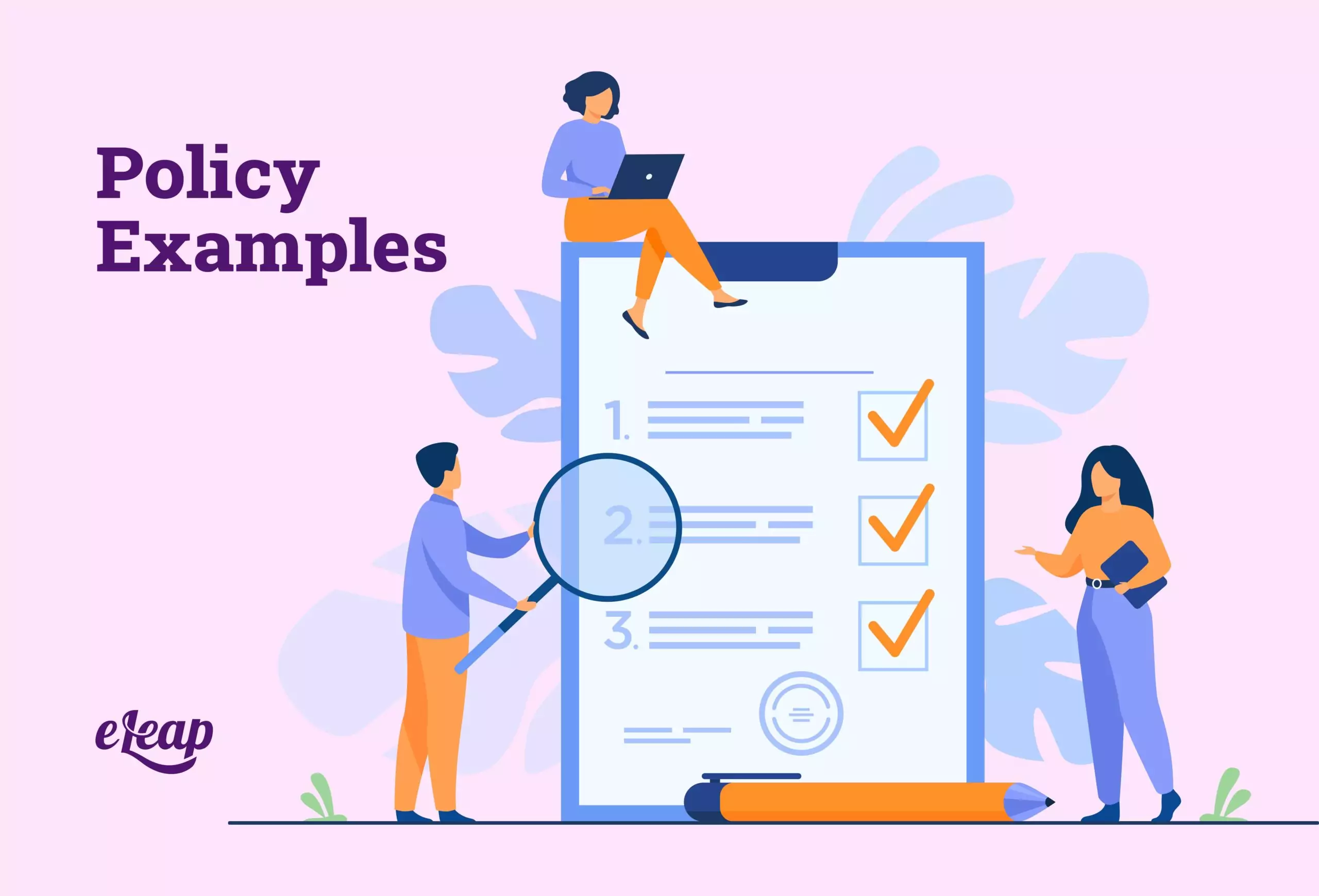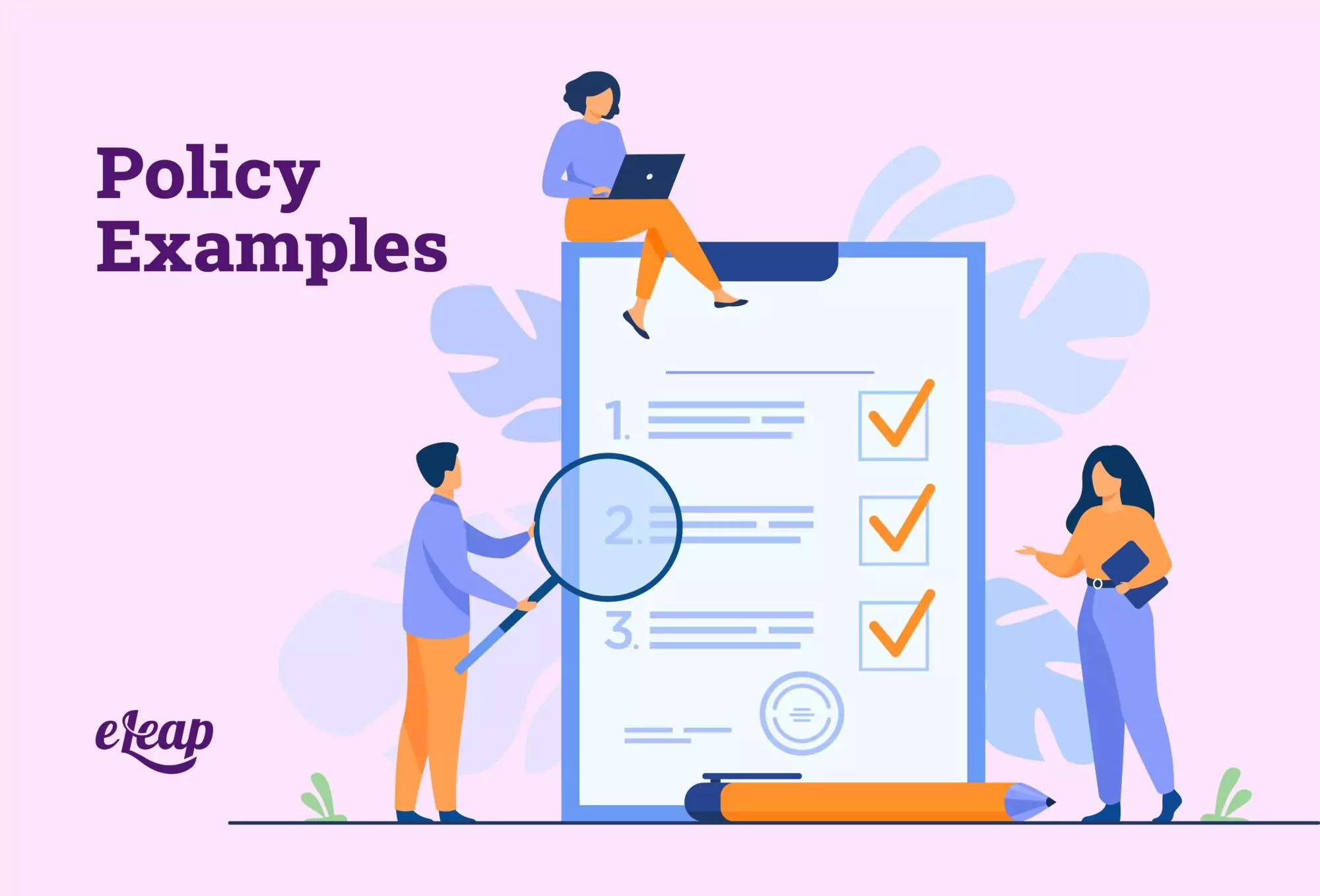Policy Examples
What are some policy examples of good policies?

When you’re in charge of a business or an organization, it can be hard to know exactly what to do and how to do it. There are a million different things you have to keep in your brain and messing up even one thing can cause your whole business model to stutter and come to a halt. To move your business to the next level, you will need policies and procedures. We share some policy examples for you to follow.

Don’t let this happen to you!
When it comes to business, it’s possible—and likely, actually—that any issues that crop up will come from your employees, rather than you. As the boss, it’s your job to make sure that what you want from your employees is explained clearly.
It’s also good to make sure that they understand what you want before you send them off to get to work. When it comes to moments like these, there’s something that will help you.
The thing that will help you is business policies.
Business Policies
What is meant when someone mentions a business policy? Well, at its most basic description, a business policy is a set of rules or regulations that you—as the leader or owner of your business or organization—have come up with.
There are different reasons behind different rules you might come up with for your employees. Some of them are federally mandated, such as privacy laws, health and safety laws, and ethical work laws.
Others, however, will be designed by you to make sure that your employees are doing what you want when you want them. Also, your rules will be used to make sure that the actions your employees take are held to a specific standard.
So long as you are clear with your business policies and make sure that everyone on your team is aware of what standard of excellence you expect, you can make a product that everyone is happy with. Additionally, you can make a product that your customers and clients are happy with, as well.
And if you have happy customers, you’ll get more business.
Why Are Policies Important?
Company policies tell your employees what you expect from them and also make sure that you’re providing a set amount of excellence to your customer.
But that’s not the only benefit of creating a company policy for your business.
When you create a company policy, it makes a firm declaration of what you’re expecting from your employees and your team.
Policies can vary across many themes and topics. They can be related to performance, values, or behavior.
Also, once you have your company policies down on paper and you make sure that your employees are aware of them, you can use them as warnings. Because company policies clearly state what you expect of your employees and what you expect out of the organization, if an employee is being non-compliant, you can point to exactly which policy they’ve acted against!
You can use company policies to tell employees what the consequences are of failing to abide by the rules, which can help you if an employee tries to fight back or imply that you’ve misled them in some way.
Company policies can be important for other reasons, as well. With company policies, you can make sure to announce your expectations. You can also use them to keep your management team honorable and less likely to mistreat anyone working under them. They can work to make sure that everyone on your team is treated fairly.
What Policies Are Best?
Unfortunately, this isn’t an easy to answer question. Policies don’t tend to fall into neat categories of “good” or “bad.” Instead, they tend to either be “useful to you” or “not useful to you.”
Although some policies tend to be more common than others, you need only choose the policies that are best for you and your specific organization’s needs. Having said that, the rest of this article will include some of the most common ones.
Again, this article stresses that you should only choose the ones that work best for your organization.
Equal Opportunity Policy
This is a common policy around the world. Many places mandate that you must be an equal opportunity employer by law.
When you claim to be an equal opportunity employer, that means that you don’t discriminate against anyone’s race, religion, gender, sex, etc. The official definition is that an equal opportunity policy prevents companies from discriminating against job applicants or employees if they are a member of a protected class (e.g., race, gender, age, religion, familial status, color).
This is the best sort of policy to have on hand when it comes to potential workplace harassment. If you want to make sure that you have your bases covered when it comes to anti-harassment, workplace violence, non-discrimination, or diversity policies, this is the policy to adopt.
Workplace Health and Safety
Another one that is very common for most organizations, this policy makes sure that you’re not overworking your employees and that you’re making sure they’re safe and cared for when it comes to their health.
It’s important to provide your employees with a safe and healthy work environment, especially since workplace health and safety violations can cause harm to your employees, cost your business money, and damage your reputation.
When it comes to organizing your business and creating these policies, there are a few things you should consider. Perhaps you’ll want to highlight what your team needs to do if there’s an emergency in the office or if they might come into contact with hazardous materials.
The Occupational Safety and Health Administration (OSHA) has guidelines on how to create a safe workplace and protect your workers from occupational hazards. You can use the OSHA policies to work your policies into your organization.
Employee Code of Conduct Policy
Another very common and important one, no matter what field of business you’re going to be working in. This policy acts as a well-defined and detailed policy that details how you expect employees of your corporation to act.
This is the policy wherein you tell your employees how they need to conduct themselves as an extension of your business. This policy might include specific rules related to substance abuse, sexual harassment, giving gifts, dress code, confidentiality, and even the use of cell phones or social media during work hours.
This sort of policy can be as robust or slim as you like, but it’s always best to make sure that it covers all the bases that might lead to problems.
Keep in mind that, even if you manage to make a perfect policy of conduct, there will still be moments where your employees misunderstand. If this happens, make sure to refer to your policy so that you can reiterate what your expectations are.
Attendance, Vacation, and Time-Off Policies
Most employees dream of having a day off from work. It’s not a statement about your organization or anything—there are just some people who dream of not having to come into the office.
When it comes to these sorts of employees, it’s best to have clear information about what they should expect when it comes to vacation days.
If you have a specific and regulated way for your employees to request time off or go on vacation, it can help keep everything in your office running smoothly. Your time-off policy should make sure to outline how much time off your team will receive automatically, how much PTO they’ll receive, how much they accrue, how they alert you that they’d like time off, and the like.
You can also choose to create a separate attendance policy that outlines what is considered tardy, how far in advance they should request time off, and what happens if they don’t show up for work. It comes down to how you want to run your organization and what you expect from your employees.
Employee Disciplinary Action Policy
This is another very important policy and one that you might want to think about before you dismiss it.
When it comes to your employees, they’re going to want to know what the penalties are for stepping one toe out of line. Is one infraction going to cause them to get fired? Is it three infractions? The size of the infractions?
You need to be clear with them so that they understand what the consequences of their actions are going to be if they—knowingly or unknowingly—go against company policy.
Before you can hold your employees accountable for their actions, it’s important to record your expectations in terms of performance and behavior in your employee handbook or individual employee contracts. With complete access to the rules and regulations of the workplace, you can then enforce disciplinary action when appropriate while using the employee handbook as a point of reference.
You can make a simple step-by-step list of what they can expect to happen to them based on which policy they’ve broken. This will allow you to make sure that you’re treating all of your employees fairly when it comes to their conduct, but also with their disciplining.
Other Thoughts
Keeping all this in mind, realize that policies are extremely helpful, but they’re not infallible. You’ll inevitably find that some policy you’ve come up with has a loophole or that someone has found a way to game your system.
When this happens, don’t panic! All you have to do is look into revising that particular policy. Making sure that your policies are relevant and up to date can save you from many headaches down the road.
It also helps to work with a lawyer to make sure that all of your policy choices are worded correctly and lack as many loopholes as possible.